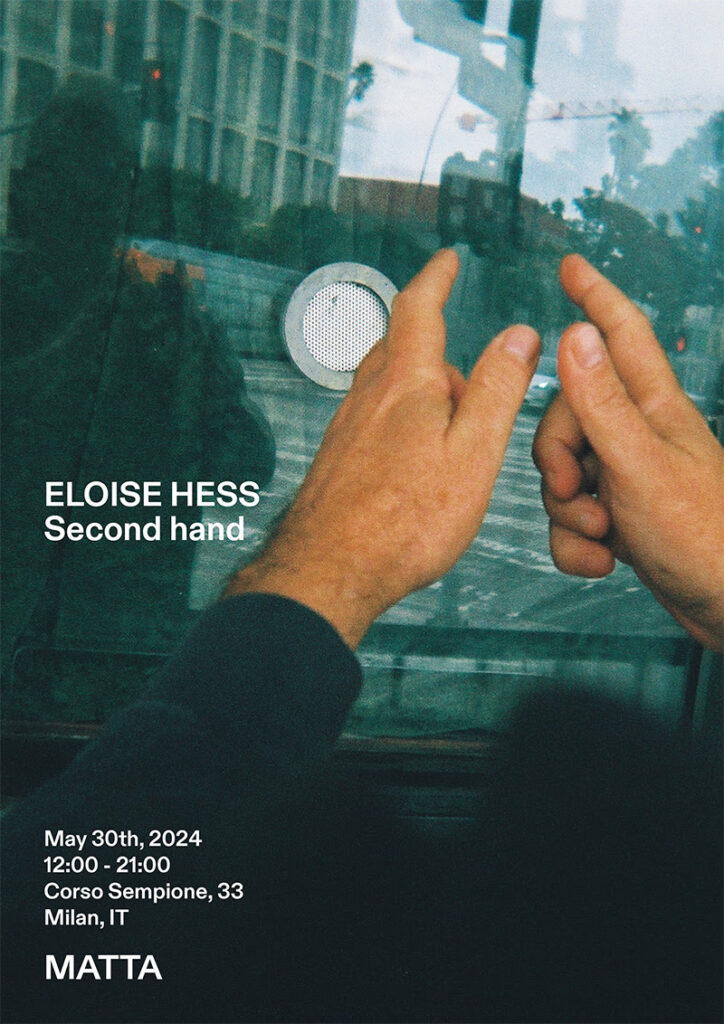SECOND HAND
Text by Jennifer Pranolo
“...the picture is first felt by us...”
–Jacques Lacan, “What is a Picture?”
Within the series, a gesture repeats. Each time it appears, it is not the same. Yet also
each time, it is of hands reaching. They overlap, once, almost into a prayer; in others,
they grasp, unevenly, for something that is not there. Reaching repeatedly, the hands
frame an intention: a desire to see.
*
The photographs are taken on a disposable camera. The ease of the single-use, point-
and-shoot facilitates the promise of photography: an instantaneous mastery of space
and time in the making of a record, on sight, of light writing itself into memory. An
instrument of capture, the camera is a dark room for this precise aim of seizing the
present as it passes, a seeing that can be held and seen again.
*
But it is a painting that holds the photograph—or photographs, twelve selected from
nearly five hundred—of the missed aim to make a picture out of what is seen. The artist
Eloise Hess (b. 1995) collaborated with her father Charles Hess (b. 1961) to register the
slow-motion atrophying of the linkages between the hand, mind, and eye; the lapses, an
accumulating discontinuity, between his actions and his intention. One gesture replaces,
or imperceptibly iterates, the other; one way of seeing, through one medium, falters,
while attended to, in another medium, by a different way. In the lag, the image forms.
*
Paintings are not photographs. The latter historically supersede the purpose of the
former as imitations, or representations, of reality. Like modern acheiropoieta, icons that
are not made by hand, mere presence leaves a mark, verifying contact with the
insubstantial. The photographic impulse to fix this circuit of truth and touch into a picture
of, a clear likeness or impression, devolves, in Hess’s paintings, into an intensive blur.
Translucent shadows, edges, and occlusions arise as the camera slips, descends, turns
inward, away. Dim gradations serially displace sight.
*
A sense of passage permeates these paintings—but how? Moving neither forward nor
backward, the image is extracted from its photographic substrate and reassembled on
multiple sheaths of silkscreen and inkjet prints or transfers bound by alternating layers
of encaustic in a vertical still of stacked process. Where the successive frames of a
projected filmstrip can create the illusion of cinematic continuity aided by the fallibility,
the slowness, of the human eye—here, the desire of painting, its unfolding of a gesture,
of many, and more, gestures, interrupts the photograph’s single plane. Time, gesture,
and desire indivisibly expand a singular instant.
*
The medium of desire is time. Desire never attains its aim, just as the second hand on
an analog clock keeps time at a distance by elongating, indefinitely, the space between
the minutes and hours that divide a day, or a life. Vision, alongside desire, persists in
afterimages. Hess photographs her father—a photographer experiencing the
incremental forgetting associated with early-onset Alzheimer’s disease—trying to see as
his capacity to picture the world, to remember and put it in order, fades. The obscure or
not taken shots that her paintings discretely develop do not offer a revelation but instead
point to a shared time. A desire to touch time’s movements through sight opens the
orientation of the picture, and the relation, to change.
*
The poet Arkadii Dragomoshchenko begins his book Xenia with a scene of reversible
reciprocity that turns on seeing oneself being seen, wanting, oneself, to see: “We see
only what / we see // only what / lets us be ourselves— / seen.” It is a seeing that one
feels.
_______________________________________ |

